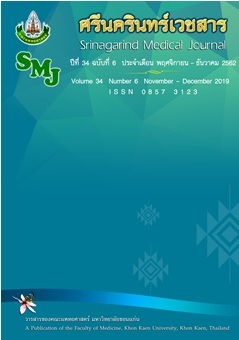The Three-Dimensional Modeling from Computed Tomography Images by Three-Dimensional Printing
Keywords:
การสร้างโมเดล 3 มิติ; การพิมพ์โมเดล 3 มิติ; อะคริลิกแฟนทอมAbstract
Background and Objective: The 3D printing could be applicable in many fields. In this study, 3D models were constructed and printed according to size and shape of acrylic phantom. This study aimed to test the accuracy of 3D modeling for 3D printing.
Methods: The acrylic phantom was scanned by CT equipment storing data in a DICOM image format. Then the 3D model was created for 3D printing. Evaluate the results from the 3D model printed against the acrylic phantom, by assessing shape and size with sighting and measuring the width, length and height of each layer, and compare the differences by percent error.
Results: When visual assessment was performed, the 3D model and acrylic phantom, had the same size and shape. And the width, length, and height of each layer had a percent error less than 2 percent.
Conclusion: In this study, to create and print 3D models had a size and shape expectation of less than 2 percent, error.
References
2. Ventola CL. Medical Applications for 3D Printing: Current and Projected Uses. Pharmacy and Therapeutics 2014; 39: 704-11.
3. Gross BC, Erkal JL, Lockwood SY, Chen C, Spence DM. Evaluation of 3D printing and its potential impact on biotechnology and the chemical sciences. Anal Chem 2014; 86: 3240–53.
4. Ciuffolo F, Epifania E, Duranti G, De Luca V, Raviglia D, Rezza S, et al. Rapid prototyping: a new method of preparing trays for indirect bonding. Am J Orthod Dentofacial Orthop 2006; 129: 75–7.
5. Lipson H. New world of 3-D printing offers “completely new ways of thinking:” Q&A with author, engineer, and 3-D printing expert Hod Lipson. Institute of Electrical and Electronics Engineers Pulse 2013; 4: 12–4.
6. Hieu LC, Zlatov N, Vander Sloten J, et al. Medical rapid prototyping applications and methods. Assemb Autom 2005; 25: 284–92.
7. Banks J. Adding value in additive manufacturing: Researchers in the United Kingdom and Europe look to 3D printing for customization. IEEE Pulse 2013; 4: 22–6.
8. Ursan I, Chiu L, Pierce A. Three-dimensional drug printing: a structured review. J Am Pharm Assoc 2013; 53: 136–44.
9. Cui X, Boland T, D’Lima DD, Lotz MK. Thermal inkjet printing in tissue engineering and regenerative medicine. Recent Pat Drug Deliv Formul 2012; 6: 149–55.
10. Rengier F, Mehndiratta A, Von Tengg-Kobligk H, et al. 3D printing based on imaging data: Review of medical applications. Int J Comput Assist Radiol Surg 2010; 5: 335-41.




